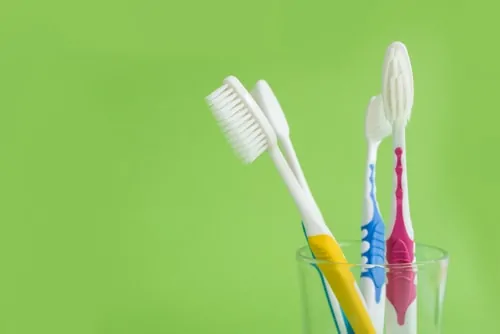
No matter what type of toothbrush your little one uses, it’s important that you know the best way to take care of it. The truth is, your pediatric dentist in Spring will tell you that there are “rules” to proper toothbrush care. To make sure your child’s toothbrush lasts as long as possible and to keep it germ-free, follow our top toothbrush care dos and don’ts.
Rinse – Sometimes our patients believe that they need to soak their child’s toothbrush in mouthwash or other germ-killing concoction. We’ve even heard of parents tossing toothbrushes into the dishwasher. However, neither of these extra precautions are necessary, and running a toothbrush through the dishwater can actually do more harm than good. Simply rinsing toothbrushes with warm water will do just fine. Make sure to thoroughly rinse off your child’s toothbrush after every use, cleaning out all leftover debris or toothpaste from the bristles.
Store – The best way to store a toothbrush is upright and allowing it to air dry. This dries out the toothbrush and makes it difficult for bacteria to stay alive and flourish. Keeping toothbrushes upright helps to drain the excess liquid and can speed up drying.
Replace – Your pediatric dentist in Spring recommends replacing your family’s toothbrushes every 3 to 4 months. However, there are times when you may need a new toothbrush sooner rather than later. If you or your child is sick, replace toothbrushes as soon as you’re feeling better. Also, if the toothbrush bristles begin to fray, it’s time for a new one.
Share – Usually when we talk to kids about sharing it’s to encourage them to do so. However, when it comes to toothbrushes, sharing is definitely not caring. Using someone else’s toothbrush can easily spread bacteria and germs from one person to another. It’s also wise to keep your family’s toothbrushes stored away from each other whenever possible to avoid cross-contamination. If your little one forgets his toothbrush during a trip and you can’t immediately get another one, consider using toothpaste on a damp paper towel and brushing his teeth with that.
Cover – You may have considered using one of those fancy toothbrush holders to keep your family’s toothbrushes separated and stored. However, doing this can create an ideal environment for bacteria to grow. Bacteria love moisture, and when wet toothbrushes are enclosed in a container and are unable to dry thoroughly, bacteria can multiply and take over a toothbrush. Always store toothbrushes out in the open and allow your toothbrush to dry completely before putting it into any container.
Distance – Now that we’ve talked about how important it is to store toothbrushes upright and uncovered so they can air dry, it’s important to talk about just where to keep these toothbrushes. It may sound gross but you should try your best to store toothbrushes as far away from the toilet as possible — try for four feet at a minimum. You see, whenever we flush the toilet, particles can easily become airborne and land on your toothbrush (we told you it was gross!).
Taking good care of your family’s oral health goes beyond regular brushing and flossing. It’s crucial that you take care of the actual toothbrushes themselves. Follow these tips from your Spring pediatric dentist in order to keep your toothbrushes bacteria-free and ready to clean.